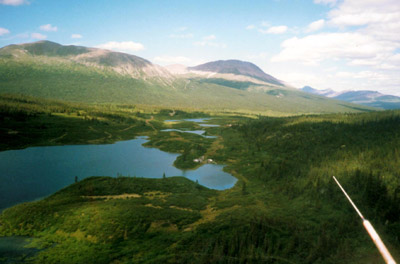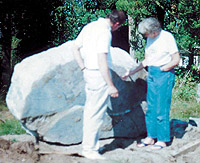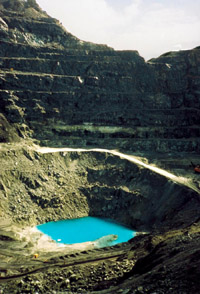 |
|||
|
|||
|
Copyright
Nephrite Jade,
HistoryJade, the nephrite kind has an ancient, romantic, oriental history. Known to the Chinese as the Stone of Heaven, it has been carved for tools and beautiful intricate works of art since Neolithic times. It is the toughest gemstone and the most difficult to polish.Jade, revered and worshipped as the center of Chinese civilization for over 5000 years, was considered "the bridge to heaven" and was an important part of their burial rites with six intricately carved ritual pieces incorporated into the ceremony. The Kunlun Mountains of China are the original "Jade Mountains" and most probably Asia's only source of nephrite from prehistoric times up to the 1700s. Jade artifacts from Yakut, Russia (formerly U.S.S.R) date back to 3000 B.C. and in Canada nephrite jade was used by British Columbia native peoples as early as 3000 years ago, mainly in the Lillouet and Lytton areas. The British Columbian native's words for jade are "squa" and "Lisht." As far as is known, Sir John Richardson made the first reference to jade in Canada around 1851. In 1871, Dawson mentioned the use of jade by the Salish people along the Fraser and Thompson rivers in southern British Columbia. By the 1700s jade sources in China had virtually dried up, but by the mid-1800s, Chinese placer miners in British Columbia were collecting jade boulders and shipping them back to China in the coffins of those who had died and were being sent home for burial. How much jade was shipped to China in this manner, over a period of about fifty years, is not known. In 1938, W.J. Wheaton discovered nephrite on Wheaton Creek in the Cassiar district. However, there was very little production from this area until about 1957 when G. Davis produced 1000 pounds from placer leases on Boulder Creek. About 1953 Captain Duncan and C.J. Halsey began collecting jade on the Fraser River near the junction of the Lillooet River. The Fraser and Bridge Rivers became popular collecting sites for rockhounds and very large boulders were being found that often weighed over ten tons. By 1958, Cecil McEwen and a few others started selling jade from Bridge River to China. Buyers from Hong Kong, Idar Oberstein in Germany and the United States became interested and so commercial trading in British Columbia nephrite began.
Winnie Robertson prospected for and found nephrite in 1967 at the head of O'Ne-ell Creek on Mount Sidney Williams, staking the Jade Queen Mine. Larry Owen and S. Porayko made discoveries on Ogden Creek, which led to finding the deposits on Mount Ogden in 1968. Larry Owen staked Fall River and Lee Creek in 1969.
Mount Ogden proved to be one of the major nephrite producers in British Columbia, which is the world's major producer of nephrite with its gigantic surface deposits. In recent years, Continental Jade Ltd. (a part of the Jade West Group, owners of the Mount Ogden property) acquired the old Mohawk Oil jade property called Kutcho Mine near Provencher Lake. Mount Ogden has been temporarily closed to concentrate on Kutcho, which is easier to work. Originally discovered by Andrew Jensen, the jade claims in the Provencher Valley were sold to Cry Lake Jade Mines, which was owned by Mohawk Oil Company and finally consolidated under the Mohawk Oil ownership. In 1967, Clancy Hubbell recognized nephrite in the serpentine being mined at the Cassiar Asbestos Mine at Cassiar, B.C. Until then, it had been considered a nuisance waste rock. Later, in 1974 Cecil McEwen made the discovery at the head of Jim Creek near Shulaps Peak. In the 1990s, a major new deposit called Polar Jade, located fifty kilometres east of Dease Lake, has been opened up with Jade West as a partner. This deposit is of jewellery quality and the material is of such high grade that it has been confused with jadeite. This has reaffirmed the position of British Columbia as producer of the highest quality of nephrite in the world.
MineralogyMinerals associated with nephrite jade are talc, soapstone, tremolite, actinolite, and bowenite.
Nephrite is a tremolitic amphibole with the formula Jadeite jade is a mineral belonging to the pyroxene group and is a sodium aluminum silicate, NaAlSi2O6. It crystallizes in the monoclinic system. Jade is the name applied to aggregates of either mineral. Some materials have an appreciable jade content, but if less than 50% of the material is jade, it is not properly termed jade, although it may be referred to as "near jade."
Although green is the usual colour of nephrite, it may range from white to near black through many tints and shades of green. Some may be mottled, streaked or spotted and go by a variety of names such as Snowflake, White Lightning, White Cloud and Mutton Fat. There is a type with a definite blue sheen that has been labeled Blue Point and is very attractive and interesting. There is also some outstanding light-coloured jade from the Coquihalla district, and a few pieces may still be around in some private collections. Another interesting variety is botryoidal jade (see Botryoidal Jade, Rarest of the Rare Jades by Duke McIsaac, in this issue.) Technically speaking, there are at least 16 colour designations in British Columbia nephrite jade. The colour preference is generally for "lively" green shades with uniform colour being preferred to mottled or variegated colours. Many think that the bright emerald green spots of chrome garnet are attractive as in the material from the Cassiar Asbestos Mine. The specific gravity of nephrite measures 2.99 on the average, which means that one cubic foot of nephrite weighs about 186 pounds. Its hardness is about 6.5 on the Mohs' scale and it is extremely tough. Compression tests on Mount Ogden jade showed that it took up to 61.2 thousand pounds per square inch of pressure to crush it! It will resist blows from an 8-pound sledgehammer. The "torn buckskin" type of fracture is characteristic of nephrite and broken edges of good quality jade will show a translucency when held up to the light. The most common impurities in nephrite are the spinel group minerals such as chromite, magnetite and chromian spinel. These may undercut and cause pitting in lapidary work. Chrome grossular garnet is found in nephrite specimens throughout British Columbia and particularly in specimens from the Cassiar Mine (which is long since closed). It is also common for tremolite to alter to chlorite composing up to two or three per cent of the specimen. The grading of nephrite is applicable only to cut blocks and varies widely from superior class to gem grade, carving grade and building stone grade. Structure refers to the grain in the material and the best is structurally isotropic- with little or no grain. The lowest grade may be structurally anisotropic. According to Dr. Bob Folinsbee of the Geology Department of the University of Alberta in Edmonton, only one fifth of one per cent of jade is true gem quality and the balance of good jade is carving and building stone. Kirk Makepeace of Jade West estimated that 20 per cent of the jade mined is saleable.
GeologyNephrite in Canada is found mostly in British Columbia along a belt of major faults and serpentinites from near Hope to the Yukon border north of Dease Lake. The three principal areas are the Lillooet, Omineca and Cassiar segments. The deposits are associated with Permo-Triassic rocks mainly of the middle Palaeozoic to late Triassic ages. "Whiterock" alteration of sperpeninite is an important clue in nephrite prospecting.According to Stan Leaming in "Jade in Canada" (1978), the largest known deposit of jade in British Columbia was the property of Cry Lake Jade Mines east of Provencher Lake. It was believed there was no such thing as jade "in situ" - but that it was always found in boulders as float. Some of these boulders might weigh many tonnes – like Mount Ogden's "Big Papa", the biggest known boulder (see National Geographic, September 1987, p. 304) – but they all have a top, bottom, and sides and are in fact boulders. However, Cassiar jade was definitely mined from bedrock and according to Makepeace, there is a unique new find at Mount Ogden with what appears to be a vein about eighteen inches wide, running halfway down the hillside. Near Provencher Lake at approximately the 6800-foot level, there is what is called the "China Wall," a vein of nephrite that zigzags across for about five miles, according to Jack Gillies of Canjade. The Kutcho Creek Jade Mine, Mohawk Jade Mine, Provencher Lake Jade Mine, Cry Lake Jade mine, and the "China Wall" are all the same jade mine (personal communication with Kirk Makepeace). In the Lillooet segment three are grouped numerous occurrences in the Shulaps Range, areas in the adjacent Cadwallader Range and along Bridge River, and the Fraser and Coquilla rivers.
Related Websites:
References:
Personal Interviews:
This article may not be copied, distributed or reprinted in any form without the author's permission. To contact the author, please use the e-mail address provided. If you are unable to contact the author, please contact the Canadian Rockhound. Authorized reprints must acknowledge the author, original source and the Canadian Rockhound. The preceding article is a modified and updated version of a series of articles first published in the Winter 1989-90 issue (Volume 2, Number 5) of Cab & Crystal, a Silver Chameleon publication. Updated July 2000.
|
||||||

Copyright © 2000 Canadian Rockhound
Back Issues |
News & Events |
Junior Rockhound |
Resources
|
|||||||



